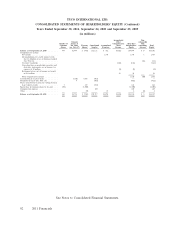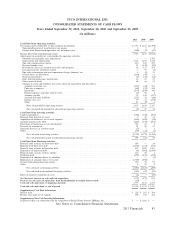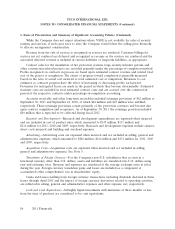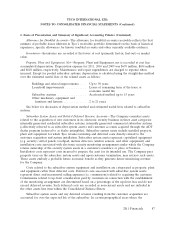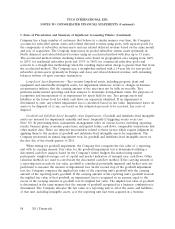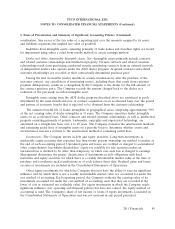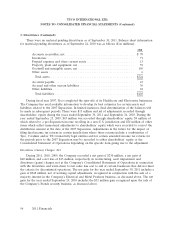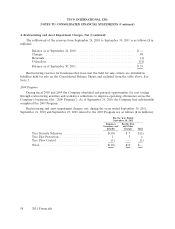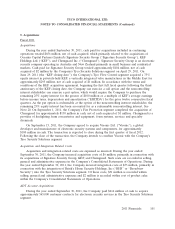ADT 2011 Annual Report Download - page 194
Download and view the complete annual report
Please find page 194 of the 2011 ADT annual report below. You can navigate through the pages in the report by either clicking on the pages listed below, or by using the keyword search tool below to find specific information within the annual report.TYCO INTERNATIONAL LTD.
NOTES TO CONSOLIDATED FINANCIAL STATEMENTS (Continued)
1. Basis of Presentation and Summary of Significant Accounting Policies (Continued)
Insurable Liabilities—The Company records liabilities for its workers’ compensation, product,
general and auto liabilities. The determination of these liabilities and related expenses is dependent on
claims experience. For most of these liabilities, claims incurred but not yet reported are estimated by
utilizing actuarial valuations based upon historical claims experience. Certain insurable liabilities are
discounted using a risk-free rate of return when the pattern and timing of the future obligation is
reliably determinable. The impact of the discount on the Consolidated Balance Sheets as of
September 30, 2011 and September 24, 2010 was to reduce the obligation by $16 million and
$21 million, respectively. The Company maintains a captive insurance company to manage certain of its
insurable liabilities. The captive insurance company holds certain investments in an escrow account for
the purpose of providing collateral for the Company’s insurable liabilities. See Note 9. Additionally, the
Company records receivables from third party insurers when recovery has been determined to be
probable.
Financial Instruments—The Company may use interest rate swaps, currency swaps, forward and
option contracts and commodity swaps to manage risks generally associated with interest rate risk,
foreign exchange risk and commodity prices. Derivatives used for hedging purposes are designated and
effective as a hedge of the identified risk exposure at the inception of the contract. Accordingly,
changes in fair value of the derivative contract are highly effective at offsetting the changes in the fair
value of the underlying hedged item at inception of the hedge and are expected to remain highly
effective over the life of the hedge contract.
All derivative financial instruments are reported on the Consolidated Balance Sheets at fair value.
Derivatives used to economically hedge foreign currency denominated balance sheet items related to
operating activities are reported in selling, general and administrative expenses along with offsetting
transaction gains and losses on the items being hedged. Derivatives used to economically hedge
dividends declared in Swiss francs through April of 2011 are reported in the Company’s Consolidated
Statements of Operations as part of other expense, net along with offsetting transaction gains and
losses on the items being hedged. Beginning in May 2011 the Company no longer declares dividends in
Swiss francs. Derivatives used to manage the exposure to changes in interest rates are reported in
interest expense along with offsetting transaction gains and losses on the items being hedged. Gains
and losses on net investment hedges are included in the cumulative translation adjustment component
of accumulated other comprehensive loss to the extent they are effective. Gains and losses on
derivatives designated as cash flow hedges are recorded in accumulated other comprehensive loss and
reclassified to earnings in a manner that matches the timing of the earnings impact of the hedged
transactions. The Company classifies cash flows associated with the settlement of derivatives consistent
with the nature of the transaction being hedged. The Company did not have any cash flow hedges
during 2011. The ineffective portion of all hedges, if any, is recognized currently in earnings as noted
above. Instruments that do not qualify for hedge accounting are marked to market with changes
recognized in current earnings.
Reclassifications—As a result of the segment realignment, prior period segment amounts have been
recast to conform to the current period presentation. See Note 21.
Recently Adopted Accounting Pronouncements—In September 2009, the Financial Accounting
Standards Board (‘‘FASB’’) issued authoritative guidance for the accounting for revenue arrangements
with multiple deliverables. The guidance establishes a selling price hierarchy for determining the selling
price of a deliverable. The selling price used for each deliverable will be based on VSOE if available,
2011 Financials 91



